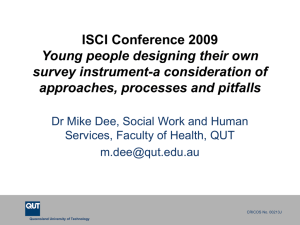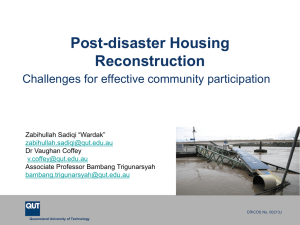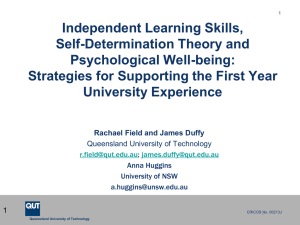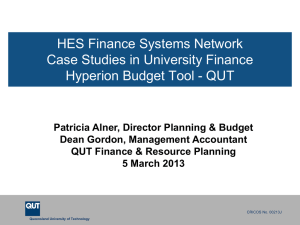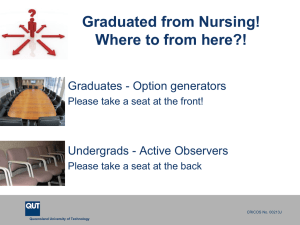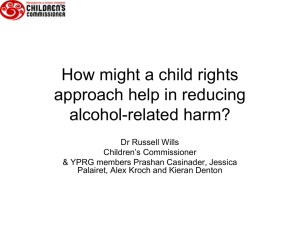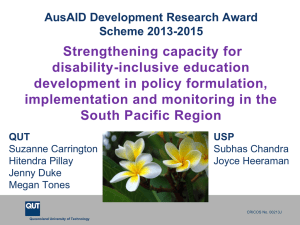Towards a matrix of rights to public space for children
advertisement
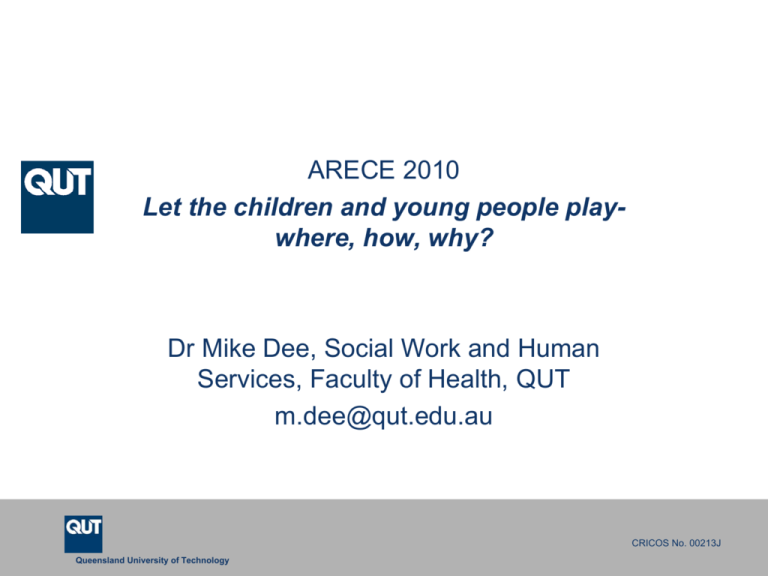
ARECE 2010 Let the children and young people playwhere, how, why? Dr Mike Dee, Social Work and Human Services, Faculty of Health, QUT m.dee@qut.edu.au CRICOS No. 00213J Queensland University of Technology The Intro………………………….. • This presentation reports on current research work with children and young people on the importance of public and private space for good health, wellbeing, social and developmental outcomes. • In many urban locations in Australia and elsewhere, public space is under attack from developers and attempts by authorities to control it (Watson 2006). Private space in the home and garden is also under attack from development densification and trends towards bigger houses on smaller plots of land where gardens disappear altogether or a postage stamp remains (Gleeson and Sipe 2006). • At the same time public policy advocates the benefits of outdoor exercise set alongside fears of using public space exacerbated by notions of ‘stranger danger’ and control measures such as child and youth curfews. Tensions frequently occur when children and young people seek to make use of a multitude of public spaces (Loader 1996; White 1999; Valentine 2004). • In this increasingly complex context, it is important to discover what children and young people value and need most in using public and private, home, space. Using a modified Grounded Theory approach (Glaser and Strauss 1967), children and young people are consulted to discover how they use both public space in parks and shopping centres and home space and the issues encountered and their proposals for improvement, to better inform policy debate, planning and formulation (ARACY 2009). a university for the real world R CRICOS No. 00213J The Intro Continued……… • In Australia over a number of years, various strategies have been adopted by local councils, police and other stakeholders such as business groups, to respond to such tensions. Rarely, if ever, are children and young people involved in meaningful ways in the design and control of public space that reflects their needs and aspirations (White 1999; Freeman and Riordan 2002; Freeman 2006). • Deploying the prisms of urban planning and law and order to deal with perceived public space issues impacts adversely on children and young people, contributing to their partial or complete removal from public space (Harris 2006; Waiton 2001). • A key problem exists in the capacity of modern, urban public space to genuinely accommodate children (of all ages) and young people’s need to experience excitement and fun in what has been termed “unprogrammed space” (Lynch 1977:71), or simply to ‘hang out’ in unstructured social space, with control by civic authorities a key concern (Valentine 1996, 2004, Harris, 2006, Gleeson and Sipe 2006). For many children and young people, their experiences of attempting to use public space are sometimes marred by the denial of everyday rights and courtesies, in youth ‘unfriendly’ spaces. • Using Public Space is important to the overall health and wellbeing of children and young people in allowing them to explore their local and wider community, meet up with friends, get some exercise and feel included in the society in which they live. a university for the real world R CRICOS No. 00213J Some of the background…………… • The recent rise of so called ‘McMansions’ and the domination in new developments of houses filling the block of land with little or nothing for children and young people to use or to call their own (Gleeson and Sipe 2006). • Proposals reported in the Victorian press for an army of ‘Nannies’ to give support to ‘troubled’ families talk of the most ‘feral’ needing harsher measures. • Jones and Sumner (2009: 42) argue that the diversity of childhood has not been well recognised and that “…there is little recognition of childhood as a culturally constructed phenomenon outside childhood studies circles…and this is a politically charged issue”. a university for the real world R CRICOS No. 00213J Child and Youth Rights • When advocates of child and youth rights seek support for arguments in favour of rights to public space and participation in the planning and ownership of spatial developments, they may reach for the 1989 United Nations Convention on the Rights of the Child or the UNCROC. Questions can be posed however, about the ongoing usefulness of this and other such instruments and whether they are as comprehensive, inclusive and durable as they need to be, given the dynamic, socially constructed nature of the categories of ‘child’ and ‘youth’ (Brown 1998; Mathews 2001; Franklin 2002). In order to develop the discussion the full paper examines the UNCROC further. • The UNCROC, adopted by the General Assembly of the United Nations in 1989, was ratified by the Australian Government in 1990 (Rayner 2002). The background enabling the UNCROC to come into being is complex, building on years of lobbying by supporters of child and youth rights (UNCROC 1989). • The 54 Articles of the UNCROC span a broad array of rights having a bearing on the position of children and young people and includes articles setting out rights to: non-discrimination, survival and development, protection from abuse and neglect, social security, health, education and an adequate standard of living (UNCROC 1989). The UNCROC can be summarized as constituting the “three Ps”, being rights to provision, protection and participation (Franklin 2002:19). a university for the real world R CRICOS No. 00213J Issues in Child & Youth Rights • Key articles in the UNCROC for the purposes of this paper are Article 14 (the right to freedom of thought), Article 15 (the right to freedom of association and assembly) and Article 12 (the right of children to be listened to in matters which affect them). Article 15 in particular, is the touchstone for many who work with children and young people around public space issues towards the creation of child & youth friendly spaces. • A central problem with devices like the UNCROC are that the “rights” contained within them are not rights in the legal sense of being both claimable and enforceable particularly as “states parties" can post reservations, thereby emasculating key aspects of the Convention (Roche 1997:32). Similarly, tensions exists between getting child and youth rights on the political agenda and seen as a significant policy area, and advocating for better rights for all humans, with coverage of these same rights to actively include children and young people (Moss and Petrie 2002). • Further problems occur with age specific rights as opposed to rights applying to all human beings, regardless of age. For example, the description of “every human being” aged under 18 as a child, as not yet adult, ignores both the diversity and complexity of being under 18 and assumes all childhoods everywhere, to be broadly the same (UNICEF 1989; Franklin 2002). The allocation of rights according to age is inherently flawed as a wide range of anomalies in the gaining of responsibilities and accretion of rights suggests (Jones 1996). Also, few aged 15-17 think of themselves as children and in some legislatures they may be legally entitled to marry and serve in the armed forces, but not to vote at elections or to drink alcohol (Brown 1998). a university for the real world R CRICOS No. 00213J The Following Tables….. • Child and Youth Friendly spaces have important features as outlined in the 3 studies contained in Table 1. • Table 2 charts the range of factors in the gaining of rights to public space. • Table 3 represents the gaining of rights as a dynamic process. a university for the real world R CRICOS No. 00213J Table 1: Key factors in youth friendly public spaces: Wooden (1997) in Melton City, Victoria Chawla (2002) in an 8 country research project Dee (2008) in Brisbane and Logan Environment Acceptance Friendly people Good entertainment No violence Sense of safety No drugs or alcohol Affordability Support and help Under 18 places No adults or police Safety Free movement Places to meet Cheap transport Open politics No violence Spaces/places to hang out Other users about in public space Affordable transport Good environment Safety Affordability No violence No drugs Acceptance and belonging in the community a university for the real world R CRICOS No. 00213J Discussion of Table 1 • Wooden’s (1997) research for Melton City Council (near Melbourne) involved a survey of 167 young people to gauge their idea of youth friendliness and suggestions for places to audit. Seventy local businesses and services were also surveyed to give them an opportunity to indicate what they understood to be friendly about their business or service (White 1998:36). • The project involved giving a youth friendly rating to 25 places in Melton, including both private and public space and shops. The kinds of places chosen for the audit included youth outreach services, health services, bowling alley, cinemas, entertainment arcade, parks, retail outlets, library, music shop, fast food shop, skate park and leisure centre (White 1998:38). • Chawla’s (2002) work on the Growing Up in Cities project draws on research undertaken in urban and rural case studies in Argentina, Australia, the U.K., India, Norway, Poland, South Africa and the U.S.A. The characteristics of youth friendly space indicated in Table 1.0 share a wide range of commonalities despite considerable cultural, political, social and economic differences between the contexts. • As Chawla (2002:220) notes, “The agreement among these young people as to what constitutes engaging or alienating places, across different nations suggests that the project has uncovered enduring and widely shared views”. a university for the real world R CRICOS No. 00213J Table 2: Child and youth rights in public space: a model in progress: Catalysts for change Social citizenship Physical factors Opportunities for change Threats to beneficial change Children and young people are valued more by society. Civil, social and political rights need to be extended to include health, education, work, housing, public space and economic rights more generally. Public space should be maintained and improved, taking the needs of children and young people into account and responding to ideas. Policing of public space can easily become more coercive, where risk management frames dominate all other considerations- (e.g. technical advances in CCTV can lead to more and more intrusive surveillance). Child and youth friendly spaces are more readily available. Citizenship at the maximal rather than minimal levelrecognising the affective dimensions of young people’s sense of belonging as a key part of social rights. Rights, standards, protections and expectations of all users of public space to be articulated. There is an opportunity to involve children and young people in negotiating new relationships with institutions, spaces and the community across generations. Key references: France(1997), Valentine (2004), White & Wyn (2004), Skelton (2007). Key references: Marshall (1950), Jacobs (1965), Tonkiss (2005), White & Wyn (2004). Key references: Chawla (2002), Malone (2006). The UNCROC is revised to be more inclusive of different youth and childhoods. a university for the real world Research demonstrates they have the capacity and interest and that a sense of belonging is key to their frame of citizenship. Key references: Chawla (2002), Heywood & Crane (1998), Dee (2008), White & Wyn (2004). The ‘new economy’ pushes young people to engage in ‘approved’ of leisure time tied to consumption, rather than ‘hanging out’. The impact of the Global Financial Crisis leads to greater impoverishment and control measures to maintain urban law and order. Anti-terrorism laws alongside Child Protection Legislation can be used as a platform for further control measures in public space and the exclusion of both ‘threatening’ and ‘vulnerable’ individuals and groups. Key references: Mitchell (2003), Watson (2006), Harris (2006). R CRICOS No. 00213J Discussion of Table 2 • Table 2 indicates the range of approaches and concomitant issues discernable in much of the literature relating to children, young people and their use of public space. A broadly based human rights based approach lodged in conceptions of social citizenship, provides an important way of (re) configuring debates about public space. • The strategy adopted by Copeland (2004) is an interesting starting point, in looking at the application of common law and anti-discrimination legislation around the age based exclusion of young people from shopping malls. Copeland’s project identifies the legal vagaries of what constitutes ‘private’ space and also the discriminatory practices of security personnel and others, in excluding some children and young people from malls and shopping centres (Copeland 2004). The general allure of the mall for children and young people of in terms of a meeting place, entertainment, food, cinemas, etc. is strong, with contextual niceties like heating in northern hemisphere locations, where the mall may be the warmest, most brightly lit place to go on a dark winter day (Dee 1995). For young people in Australia, the mall may literally be the coolest place to go on a hot and humid day (Harris 2006). • Copeland’s approach, while specific to the quasi-private space of the mall, seeks to promote the clarification of broadly based human rights declarations around freedom of peaceful assembly and freedom of association. These declarations, contained in the UNCROC connect with efforts to articulate social citizenship based rights for children and young people, to be in public and hybrid-public-private forms of space as article 15 declares (UNCROC 1989). a university for the real world R CRICOS No. 00213J Child and youth rights to public space: possible stages in progress • Table 3: Public space is more child and youth friendly Optimal sociospatial conditions Citizenship has more meaning for children and young people as a greater sense of positive recognition, belonging and optimism is experienced a university for the real world The nature of institutional relationships changes R CRICOS No. 00213J Discussion of Table 3 • Table 3 describes a dynamic process reliant on a number of catalytic factors that could promote rights to public space for children and young people. Of key importance is the suggestion by Skelton (2007) that the UNCROC requires review and updating to take account of the changing nature of childhood and the diversity of childhood(s) around the world. Additionally, the valuing of children and young people is necessary to underpin developments in public space. • Bolzan’s report for the National Youth Affairs Research Scheme (NYARS) entitled Kids are like that! Community attitudes to young people (2003), found that a complex array of views and negative stereotypes about young people exist. The maintenance and amplification of stereotypes is unfortunate as these kinds of issues matter greatly to young people. Many of my survey responses on citizenship coalesced into a description of how respondents feel they belong (or would like to belong) within a community and local area. The overriding message from the data is that feeling wanted and identifying with a locality is crucially and developmentally important to young people. This is consistent with the view that such belonging helps children and young people form their sense of identity and social citizenship at the local and wider societal level (Chawla 2002, Stanley, Richardson and Prior 2005, Gleeson and Sipe 2006). a university for the real world R CRICOS No. 00213J Children and Young People Using Public Space: Closing Points • In adopting an approach based on key social, civil and political rights, including the right to a sense of belonging, rather than the presumed wrongs of children and young people, their aspirations and potential come to prominence, requiring a policy response that is more sophisticated and genuinely engaging than may be the case currently (Gleeson and Sipe 2006; Franklin 2002; White and Wyn 2008). • In a multitude of ways in many locations worldwide, public spaces are under attack from developments and control measures seeking to exclude children, young people and others (Watson 2006). In this climate of rapid sometimes violent, change within the nature of public space, it is becoming increasingly and highly contested. • Perhaps there really cannot be too many rights which support the active use and enjoyment of all forms of public space, by children and young people. Gleeson (2006) suggests that viewing public space issues through the lens of social citizenship alongside the connected elements of civil and political citizenship, can revitalize and restore public space, something that ever increasing attempts at control, policing, camera surveillance and more stringent exclusion of ‘undesirables’, cannot achieve. • In promoting greater understanding and tolerance of the rights and needs of all users of public space, the spirit of Jacob’s (1965) hope for the generations to mix together, sharing community infrastructure and yet maintaining personal safety and dignity, might become a reality for more children and young people around the world. a university for the real world R CRICOS No. 00213J More Closing Points…………………. • The real valuing of children and young people is most critical to this process, as noted in the previous century, in this observation by O’Connor (1991): • “Youth and children are non-people. They have been objectified, theorized and explained away and denied a legitimate voice. Our views of non-adult life (childhood and youth) reflect an idealized view of adult and child relations. This is because their actual treatment is harsh and punitive, but the attitude to them is clouded in paternalism and protectionism. Society dehumanizes the young and the economically vulnerable” (p.7) • Clearly this is a dated commentary and much has changed over the years, but if we consider rather more recent evidence on this topic, then O’Connor’s views may well still be accurate. The Institute for Public Policy research (IPPR) in the U.K. recently published a report indicating that substantial numbers of people living in British cities express varying degrees of fear about and dislike towards, some children and young people (Margo and Dixon 2006). The authors note that while their study is about British young people, Australian young people “were not that different” and that there were major “cultural and social similarities” (Margo and Dixon 2006:9). • (Contact author for details of references cited or see full paper). a university for the real world R CRICOS No. 00213J
